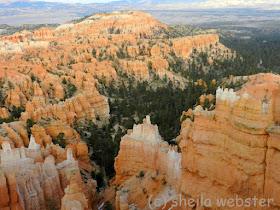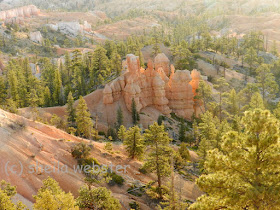We have seen some beautiful sights in Bryce Canyon National Park Bryce Canyon
The expectations for the sunset are almost forgotten as we see the incredible sights before us. Sometimes I need to remember to just enjoy what I see, not just what I expect. Hoodoos are an odd-shaped rock or pinnacle left after the results of years of erosion and Bryce Canyon
We are now at Sunset Point which overlooks the views of the Bryce Amphitheater. Geologists say the forces that began this formation known as Table Cliff and Paunsaugunt Plateau began over 10 million years ago. Impossible to realize all that has occured during that time and the sight we see now is absolutely amazing.
There are many amenities in Bryce Canyon National Park
Bryce Canyon sits in the National Forest that was once named the Powell National Forest Colorado River . It was renamed the Dixie National Forest
 |
| Tree sits atop the rock in Bryce Canyon |











































